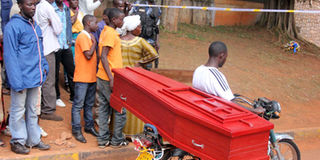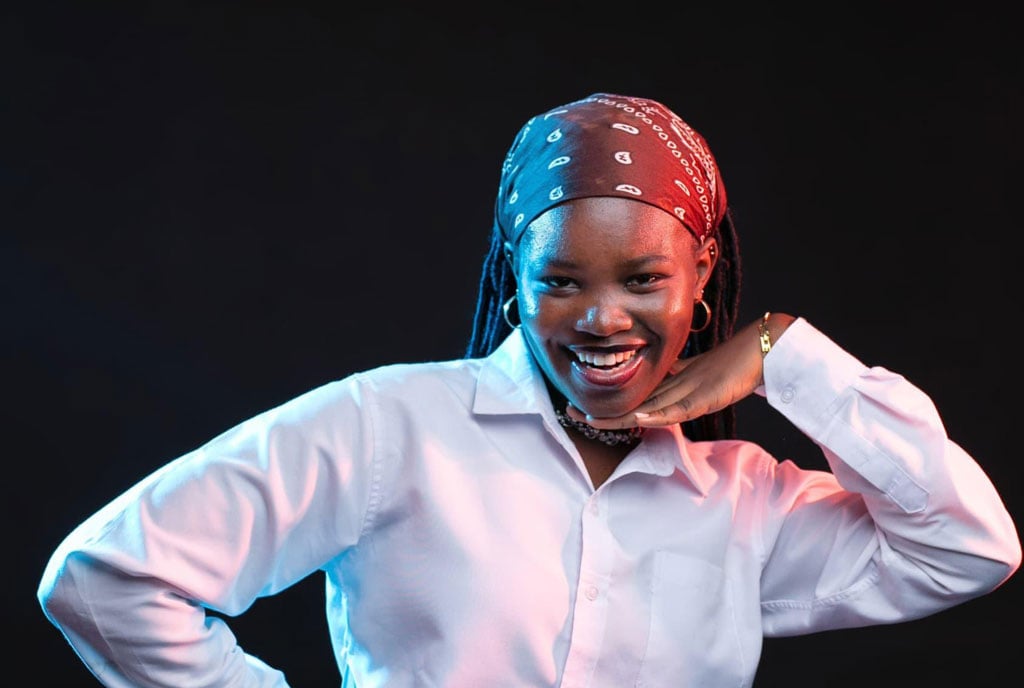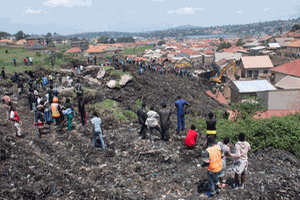Prime
Mulago hospital: scene of horror and hope

A coffin being taken to the home of one of the accident victims
What you need to know:
As people continue to pitch camp at the referral hospital and pray for their loved ones to survive, others are wracked with grief, waiting for the DNA test to identify the bodies of their relatives
The scenes cannot get more horrific. One strained glance and a sudden blindness takes over the eyes. Another attempt to see the patients literally makes the skin crawl as the heart beats faster than normal. Then when one has gathered the courage to come closer and speak to them, a sudden eerie feeling of heat emerges, you virtually feel as if a petrol fire has engulfed you. The trauma can get that bad. Save the doctors who by virtue of their calling seem to get used to such sights, one can see it in the faces of the attendants, in the trembling hands of journalists making notes or taking “good” shots.
We are talking about patients in the afternoon of their life. Early and mid-twenties. That cross section of Uganda’s dare-devil, ambitious and risk-all-to-get-it population. Ailing and not wailing in pain, no words can describe.
They can raise neither a finger nor a toe. Some of these digits were severely burned by fire and have dropped off, while others are folded with no nails. Their heads are hairless and look deformed, twice as big, with some having their eyes popping out and others bulging. Ears look malformed. Tongues are terribly injured and so swollen.
We are talking about a people that will confide in you and wish they had died instantly in the fire. Swollen chests, charred cheeks and necks, genital areas wounded, thighs and legs virtually reduced to small logs... It is in this ward that you learn to appreciate the medical profession. These sights, and particularly the immense pain of the victims is simply indescribable. Simply heartbreaking. Simply unbelievable.
A few metres away from Chrysostom Senono is Charles Kasule whom I bumped into a day after the accident as he was wheeled from one room to another. As of Sunday, he could afford to speak a word albeit with difficulty. As of Monday, he can communicate with a little ease now. The fire had peeled off his skin from waist to toe but he is on a sure path to recovery.
This is Mulago hospital’s ward 2C which has over 24 victims of the tragic Namungoona fuel truck accident since Saturday.
Some of them have since passed on. Others are clearly fighting for their lives. Whether they make it and tell their stories, remains a matter of prayer but all hope is not lost, if the scores of friends and relatives scattered outside the ward are anything to go by.
Children, teenagers, mothers, fathers, and bodaboda riders are all here to show their sympathy and express support and above all, attend to the patients. The hospital security staff, backed up by the police, will not allow them into the ward in as many numbers as they wish.
When the security chief calls out a patient’s name and asks only two people to enter, eight dash to the door and argue their case out, “He is our son, all of us, who are you to stop us?” one of them charges at them. The security officers do not relent to pressure however.
“The doctors have advised us to regulate the numbers. People need to understand that burns victims easily react to high temperature and can suffocate and die due to crowding,” the hospital’s spokesman Enock Kusasira, explains. They have since set up a tent for all attendants to sit and streamline communication from and to the hospital.
There are women eating katogo (mixed food), seated on mats with their bags at chest distance, a trace of resilience, the readiness to stay here till their family members are discharged.
‘I didn’t know my son had become a boda boda rider’ – a mother’s story
Maryln Linda Nsemere, a resident of Kasubi, a Kampala suburb, had not the slightest idea of her son’s new trade. Twenty-two-year-old Crystom Senono had since left his father’s home and established his own in Nsambya. The husband of a six-month pregnant woman was a carpenter, at least that is what the family knew, until the tragic fuel truck accident that happened at Namungoona.
“It was my husband’s sister who got to know first. We are told he kept screaming her name, asking the doctors to call her and luckily the doctor knew her so he made the call,” Nsemere, a step-mother of the burn victim narrates.
“On hearing the news, she (sister-in-law) rushed to Orthodox hospital in Namungoona where she found the ambulance on its way, transferring the victims to Mulago hospital. She telephoned all of us and by 1am, close relatives and friends had mobilised themselves to head to Mulago.
I was fortunate enough to get the last taxi from Kasubi to Mulago. By 3am, there were screams from relatives and victims, all over the hospital’s casualty ward. That wailing, the ambulance and police sirens, the number of people flocking the hospital scared me stiff. By now I was psychologically prepared for anything. At 3am, I checked the theatre and confirmed he was there but we had to wait until 4am to be able to speak to him as he was transferred to ward 3B.
We had a number of questions. How did a carpenter who stays in Nsambya get involved in such a nasty accident in Namungoona where it was said boda boda men were most affected?
When we checked on him at around 4:30am, he could still speak and recognise us. It is at this point that he revealed to us that he had since switched into the boda boda business with hope of getting more money. We were both shocked and disappointed. He added that he was working for somebody and was only getting a daily commission.
On the fateful day, he was transporting a passenger from Nsambya to Nansana and he got another one to take from Nansana to Kyebando. When he reached Namungoona, he sensed the confusion as fellow boda boda men siphoned fuel from the truck. He says he moved ahead even amidst the confusion as others were doing the same. The passenger did not object either.
Five metres after they had passed by the truck, he heard a bomb like explosion and looked back, only to see wild flames that engulfed them. He then quickly fell off the motorcycle into the nearby wetland. But the wetland was already over flowing with petrol and it had by now caught fire. As he tried to lift his head upwards and shout for help, he saw fire covering him. He was basically under fire as people poured more water and tried to rescue him. He told us that he painfully watched his passenger die, and the last words he heard from him was, “onzise, musajja gwe onzise (you have killed me you man). The passenger tried to fall from the bike but landed on the fire-intensive side of the road,” Nsemere narrates.
That was the last the family heard from Senono. From that time, he has not spoken again. He communicates with them using sign language which comes with immense pain.
He is still in critical condition. His chest, head and entire face is swollen, almost twice its normal size and dripping with liquid. The chest is also swollen as he swallowed lots of petrol in the wetland. The fingers are burnt and folded though his feet were not hurt as much since he was wearing shoes but the rest of the body from legs upward to the head, are burnt terribly. The doctors have put him on oxygen support.
“If God grants him healing, of course it will be our joy but we are ready for anything to be frank with you. He was virtually roasted. It is that bad but thus is life!” is how his mother concludes our interview.
How the hospital is coping
Dr Robert Sentongo, a senior consultant plastic skin surgeon explains that the patients still need close monitoring and medical attention. The earliest they can be discharged is the end of July.
“These patients we are remaining with are critically injured. In other words, their situation is life-threatening,” the doctor reveals. Of the 24 victims admitted, so far 15 belong to this category.
On if the death toll will not rise from this group, the doctor says with a tone of optimism, “We are trying to prevent more deaths. We are doing all we can, pray for us,” adding, “the extent of damage was big since they inhaled petrol fumes so even the lungs are injured.”
The doctor explains, the physical injury as seen by the ordinary eye may not be as severe as that on the internal organs which makes the medical situation dicey. In his words the senior consultant clarifies, “You may not see much harm on the skin but internally there is grievous harm and most of the cases are of that nature but the situation is under control. We got intervention from other sections of the hospital so we have the capacity.”
On his part, the hospital’s spokesman Enock Kusasira, who prides in the casualty ward’s emergency response potential.
“We may not have had the equipment and capacity to deal with a mass number of one type of accident but we managed to galvanise efforts from different departments, ministry of Health and Office of the President and Police,” he says. The emergency ward receives more than 200 cases per day.
At the mortuary, the air of emotion and uncertainty that reigned on Sunday has significantly diminished. At that time, there were relatives screaming before checking out the list of the fatalities, with others falling on the ground on realising their loved ones were not on the list or at the casualty section. Yet their phones were off and all indications pointed to the accident.
Jaffer Katongole, a senior political mobiliser with State House returned from a function in the village and switched off his phone to have a good rest. Little did he know that by 2am on Saturday, several people were calling him.
“I switched the phone on Sunday at 9.30am and calls came from everywhere. That is how I got to know that my son had died. The police called our LC1 chairman who confirmed that he was a boda boda man known to him. It was that sad because he was my first born.” Sad indeed. But the father to the late Jaffer Kakoza was saved the suspense that comes with awaiting a DNA test.
The numbers keep reducing at the mortuary but certainly not the anguish. And yes, scattered clouds of uncertainty continue to linger. Unlike Mr Katongole, one family suffered the double tragedy of having to return the body on realising it was not that of their relative.
“We had told them to wait since they were not sure till we do the DNA tests but they instead angrily picked the body and drove away but we convinced them to bring it back and they appreciated what we were saying. They were insisting that their person was in white knickers but that is not enough,” Dr Moses Byaruhanga, the Head of Medical Services at Uganda Police also manning the Mortuary for this period shares.
Of the 34 bodies, only six remained, pending DNA tests before they are officially handed over to their families.
Why and how the DNA?
Dr Byaruhanga explains that the DNA test, done free of charge at the Government Analytical Laboratory in Wandegeya, Kampala, helps to avert cases of families mistaking bodies. A visit to the mortuary validates his point. In here, the six bodies were destroyed to skeletons, others compressed by the fire into shapes that one cannot describe.
“We take two samples from blood swabs and body tissues. The first is called the Test Sample (from deceased) and then the Control Sample (from close relatives),” the doctor explains, adding, “so the samples are run against the each other to see if the DNA is matching.”
So what happens when one has no idea of their relative? “If the family suspects two bodies, we take samples from both and get the actual one,” he explains. This process takes about one week, meaning the families of the six have until next week to bury their loved ones.
One emotive scenario is the sight of a taxi hired by one family. The body could neither fit in the taxi boot nor the coffin. This man died with hands and legs spread far apart, he had to be covered with a bed sheet and put inside the taxi, leaving the door open for it to fit. In another scenario, a man comes with a pick-up truck, and on seeing his son’s over burnt body in a mat and cushion cover, collapses. He receives first aid, gets up and staggers to the body, only to collapse again till he is helped onto an ambulance.
“We shall all die but how we die, and get buried is what hurts most, why him?” a lady screams in Luganda before the car speeds away.
Yet with all these episodes, the mortuary staff here move about their duties with a distinct touch of devotion. Their boss, Dr Byaruhanga affords a smile in his neat suit. So what keeps them moving?
“Unlike other disasters we have had like the bombings, the situation has been extremely calm. The public, police, media have cooperated with us and the hospital has been very helpful. My happiest moment which has motivated all of us was seeing the President come here to check on us. He went up to where we cut the bodies from, asked questions and this shows how caring he is to come to the last point.”
And yet this attitude, this resolve, this stamina is not limited to the mortuary. It percolates down to the security team, medics and general public. Whether such trying moments will become learning points for the masses, especially as regards keeping off petrol fires and acting responsibly, remains to be seen.




